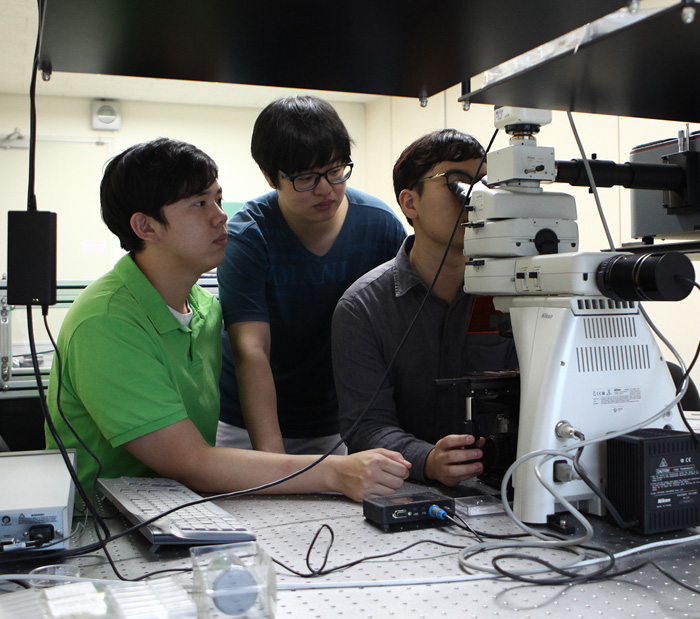Research Stories
Generating Metamaterial, Inspired by the Motion Control of an Aphid’s Leg
Metamaterials have made the exotic control of the flow of electromagnetic waves possible, which is difficult to achieve with natural materials.
SKKU Advanced Institute of Nano Technology
Prof.
LEE, SEUNGWOO
Generating Metamaterial, inspired by the motion control of an Aphid’s leg
Metamaterials have made the exotic control of the flow of electromagnetic waves possible, which is difficult to achieve with natural materials.
In recent years, the emergence of functional metadevices has shown immense potential for the practical realization of highly efficient photonic devices. However, complex and heterogeneous architectures that enable diverse functionalities of metamaterials and metadevices, have been challenging to realize because of the limited manufacturing capabilities of conventional fabrication methods.
In this research, it was discovered that three-dimensional (3D) modular transfer printing can be used to construct diverse metamaterials in complex 3D architectures on universal substrates, which is attractive for achieving on-demand photonic properties. This study is inspired by Dry-adhesion Control of the leg of an Aphid, which climbs walls without sticky materials and moves upside down on plant stems.
By Dry-adhesion Control, Aphids can regulate the attractive force between leg and object without any restriction. As described in picture 1, the surface area of the leg that is touching the object can be maximized or minimized, depending on the blood pressure of the back of the leg. In this research, a rubber stamp is designed and made to work in a similar manner with that of this insects’ leg motion. As seen picture 2, the rubber stamp with a sharp end can print anything easily due to a minimized surface area (adhesion-off) between metamaterials and the rubber stamp. Metamaterial can be removed from the maximized surface area (adhesion-on) if the sharp end crumbles.
This method provides a fascinating route to generate flexible and stretchable 2D/3D metamaterials and metadevices with heterogeneous material components, complex device architectures, and diverse functionalities.
About Research Laboratory of Biomimetic & Photonic Properties
The Research Laboratory of Biomimetic & Photonic Properties was established in 2014 as a part of SKKU Advanced Institute of Nanotechnology (SAINT). Prof. SeungWoo Lee and 7 students of undergraduate and graduate levels are researching biomimetic by using ductile nanomaterial such as DNA origami/ polymers to create various light-material interactions and more.
The laboratory is pursuing the convergence of various academic knowledges, including chemical engineering, physics, electrical engineering, and chemistry.
We participate in the competition of biomimetic design at Harvard University, and several joint researches are in development with MIT, Harvard University, and Caltech.
/생체모사+ 연성광학 연구실/
2014년 성균나노과학기술원에 (성균관대 나노과학기술학과 대학원, SKKU Advanced Institute of Nanotechnology(SAINT))설립, 이승우 교수의 지도로 박사후연구원 1명, 석박통합 3명, 학부연구생 3명이 열심히 연구하고 있다. 생체모사를 또는 DNA 오리가미/고분자와 같은 스마트 연성나노물질을 이용하여 다양한 빛-물질 상호작용들을 혁신하는 연구를 수행 중이다. 특히 꽃잎의 구조색, 사하라 사막의 개미가 열을 식히는 원리를 모사하여 태양전지/LED와 같은 광전자소자 효율을 높이거나, DNA를 이용 알고리즘 자리조립으로 비자연적 극한 광학 물성을 유도하는 “알파고 메타물질”연구를 수행 중이다. (seungwoo.skku.edu)
화학공학/나노바이오/나노화학/물리/재료공학/전자공학의 다양한 학문적 융합을 추구한다. 실제 화학공학, 물리, 전자공학, 화학을 전공한 학생들이 모여서 창의적 융합연구를 수행중이다. Harvard에서 열리는 생체분자디자인 경진대회 참석 및 MIT/Harvard/Caltech 대학교와의 공동연구 등 다양한 국제협력도 진행중이다.

